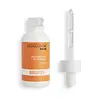What's inside
What's inside
 Key Ingredients
Key Ingredients

 Benefits
Benefits

 Concerns
Concerns

 Ingredients Side-by-side
Ingredients Side-by-side

Water
Skin ConditioningPropanediol
SolventGlycerin
HumectantButylene Glycol
HumectantPhenoxyethanol
PreservativeXanthan Gum
EmulsifyingMannitol
HumectantPhosphatidylcholine
EmulsifyingEthylhexylglycerin
Skin ConditioningResveratrol
AntioxidantPolyglyceryl-10 Laurate
Skin ConditioningCetyl Alcohol
EmollientPotassium Sorbate
PreservativeSodium Benzoate
MaskingTocopheryl Acetate
AntioxidantSodium Chloride
MaskingWater
Skin ConditioningCyclodextrin
AbsorbentGlycerin
HumectantCoco-Caprylate
EmollientSqualane
EmollientSaccharide Isomerate
HumectantPropanediol
SolventSodium Acrylates Copolymer
Hydrogenated Polydecene
EmollientGlycine Soja Seed Extract
Skin ConditioningEquol
AntioxidantResveratrol
AntioxidantXanthan Gum
EmulsifyingCetyl Alcohol
EmollientTocopherol
AntioxidantDaidzein
Skin ConditioningGenistein
Skin ConditioningLinum Usitatissimum Seed Oil
PerfumingHelianthus Annuus Seed Oil
EmollientPhospholipids
Skin ConditioningPolyglyceryl-10 Stearate
Skin ConditioningCitric Acid
BufferingEthylhexylglycerin
Skin ConditioningGlycine Soja Oil
EmollientEngelhardtia Chrysolepis Leaf Extract
Skin ConditioningSodium Phytate
Sodium Citrate
BufferingPhenoxyethanol
PreservativeWater, Cyclodextrin, Glycerin, Coco-Caprylate, Squalane, Saccharide Isomerate, Propanediol, Sodium Acrylates Copolymer, Hydrogenated Polydecene, Glycine Soja Seed Extract, Equol, Resveratrol, Xanthan Gum, Cetyl Alcohol, Tocopherol, Daidzein, Genistein, Linum Usitatissimum Seed Oil, Helianthus Annuus Seed Oil, Phospholipids, Polyglyceryl-10 Stearate, Citric Acid, Ethylhexylglycerin, Glycine Soja Oil, Engelhardtia Chrysolepis Leaf Extract, Sodium Phytate, Sodium Citrate, Phenoxyethanol
Ingredients Explained
These ingredients are found in both products.
Ingredients higher up in an ingredient list are typically present in a larger amount.
Cetyl Alcohol is a fatty alcohol. Fatty Alcohols are most often used as an emollient or to thicken a product.
Its main roles are:
Though it has "alcohol" in the name, it is not related to denatured alcohol or ethyl alcohol.
The FDA allows products labeled "alcohol-free" to have fatty alcohols.
Learn more about Cetyl AlcoholEthylhexylglycerin (we can't pronounce this either) is commonly used as a preservative and skin softener. It is derived from glyceryl.
You might see Ethylhexylglycerin often paired with other preservatives such as phenoxyethanol. Ethylhexylglycerin has been found to increase the effectiveness of these other preservatives.
Glycerin is already naturally found in your skin. It helps moisturize and protect your skin.
A study from 2016 found glycerin to be more effective as a humectant than AHAs and hyaluronic acid.
As a humectant, it helps the skin stay hydrated by pulling moisture to your skin. The low molecular weight of glycerin allows it to pull moisture into the deeper layers of your skin.
Hydrated skin improves your skin barrier; Your skin barrier helps protect against irritants and bacteria.
Glycerin has also been found to have antimicrobial and antiviral properties. Due to these properties, glycerin is often used in wound and burn treatments.
In cosmetics, glycerin is usually derived from plants such as soybean or palm. However, it can also be sourced from animals, such as tallow or animal fat.
This ingredient is organic, colorless, odorless, and non-toxic.
Glycerin is the name for this ingredient in American English. British English uses Glycerol/Glycerine.
Learn more about GlycerinPhenoxyethanol is a preservative that has germicide, antimicrobial, and aromatic properties. Studies show that phenoxyethanol can prevent microbial growth. By itself, it has a scent that is similar to that of a rose.
It's often used in formulations along with Caprylyl Glycol to preserve the shelf life of products.
Propanediol is an all-star ingredient. It softens, hydrates, and smooths the skin.
It’s often used to:
Propanediol is not likely to cause sensitivity and considered safe to use. It is derived from corn or petroleum with a clear color and no scent.
Learn more about PropanediolResveratrol is a famous emerging antioxidant. It is a good alternative for sensitive skin types who cannot tolerate retinoids.
This antioxidant is most famous for it's anti-aging benefits. Studies show it combats the signs of aging by:
Besides anti-aging, this ingredient also helps with skin brightening and soothing.
The most effective forms of resveratrol are isobutyrate and butyrate. These have the strongest effect on increasing A1 collagen and reducing inflammation.
A note on it being a retinoid alternative:
Despite it's amazing skin benefits, it is not a replacement for retinoids. However, it is recommended for people with sensitive skin or intolerance to retinoids.
Resveratrol is naturally found in grapes, peanuts, and berries.
Learn more about ResveratrolWater. It's the most common cosmetic ingredient of all. You'll usually see it at the top of ingredient lists, meaning that it makes up the largest part of the product.
So why is it so popular? Water most often acts as a solvent - this means that it helps dissolve other ingredients into the formulation.
You'll also recognize water as that liquid we all need to stay alive. If you see this, drink a glass of water. Stay hydrated!
Learn more about WaterXanthan gum is used as a stabilizer and thickener within cosmetic products. It helps give products a sticky, thick feeling - preventing them from being too runny.
On the technical side of things, xanthan gum is a polysaccharide - a combination consisting of multiple sugar molecules bonded together.
Xanthan gum is a pretty common and great ingredient. It is a natural, non-toxic, non-irritating ingredient that is also commonly used in food products.
Learn more about Xanthan Gum